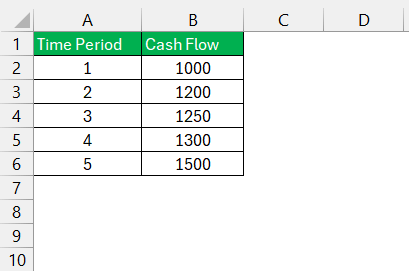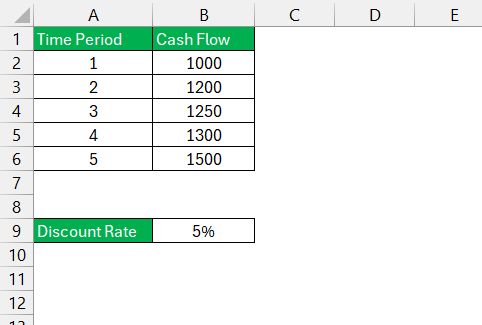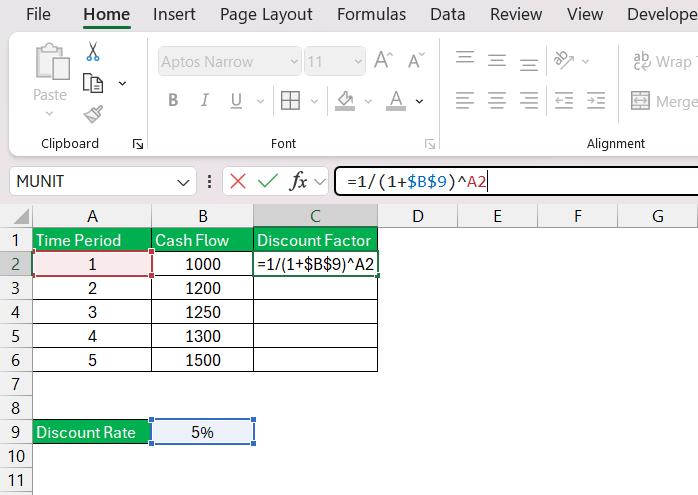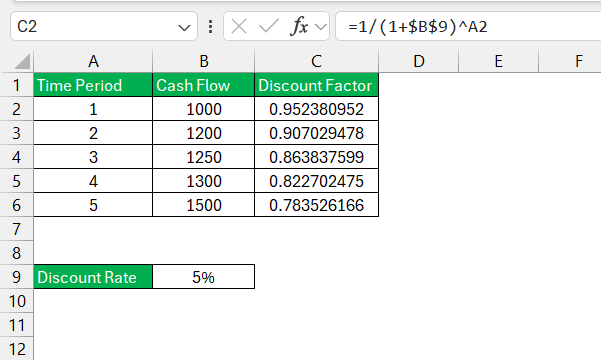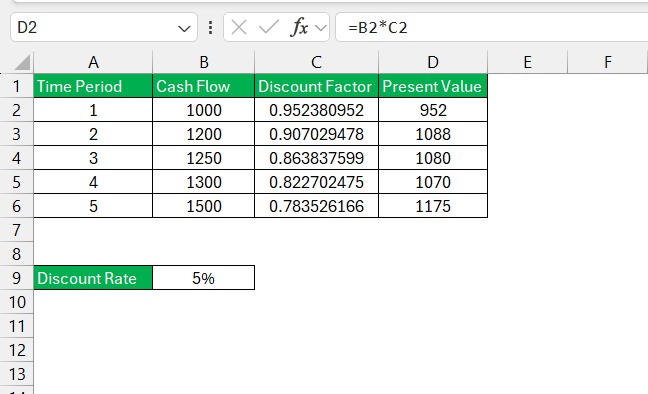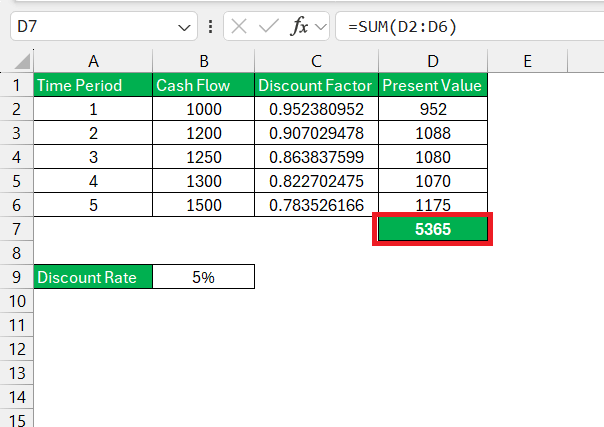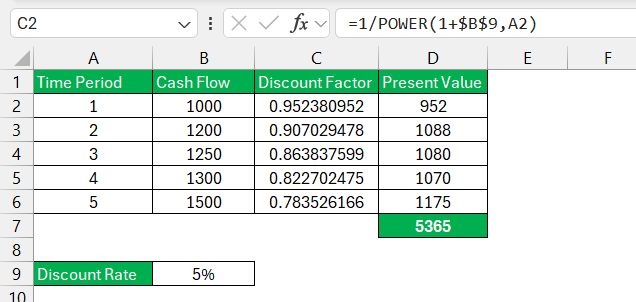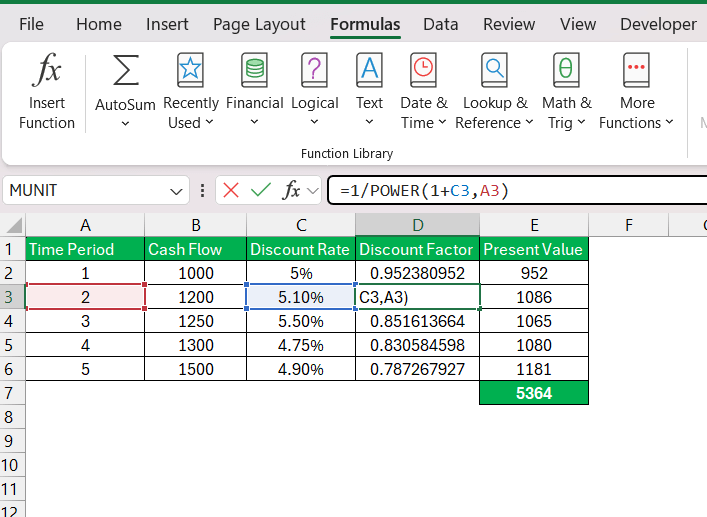When I first started working with financial models, the concept of the discount factor felt a little daunting. However, once I started using Excel to calculate it, things became much clearer. In this article, I’ll walk you through what a discount factor is, why it matters, and how to calculate it easily in Microsoft Excel.
Key Takeaways:
- The discount factor converts future cash flows to their present value by accounting for the time value of money.
- It plays a crucial role in DCF analysis, helping evaluate investment opportunities by comparing present values.
- The formula for the discount factor is 1/(1+r)t1 / (1 + r)^t1/(1+r)t, where rrr is the discount rate and ttt is the time period.
- Organizing your Excel sheet with key columns like Year, Cash Flow, Discount Factor, and Present Value ensures accurate calculations.
- Adjusting the discount rate for risk and employing methods like Monte Carlo simulations can enhance model realism.
Table of Contents
Introduction to Excel Discount Factor Concepts
Defining the Discount Factor in Excel
The discount factor in Excel is a numerical weight that assists in determining the present value of future cash flows. It’s the magic number that, when multiplied by cash inflows or outflows expected at a future date, discounts them back to their value in today’s dollars. By incorporating the time value of money, the discount factor provides a means to equate future funds with present funds.
The Role of Discount Factor in DCF Analysis
The discount factor is the cornerstone of discounted cash flow (DCF) analysis, a method crucial for finance professionals and investors to appraise the attractiveness of an investment opportunity. It quantifies the concept that money today is worth more than the same amount in the future due to its potential earning capacity.
In DCF analysis, the discount factor converts anticipated future cash flows to their present value, enabling a comparative assessment across investments and decisions. The precision of this process can significantly influence investment choices and valuations, underscoring the discount factor’s pivotal role in financial modeling.
The Essentials of Discount Factor Formula
Key Components of the Formula
In calculating the discount factor, there are several key components I must consider, each contributing to the final estimate of the present value. They include:
- The time period (t): This refers to the number of periods in the future when the cash flow is expected.
- The discount rate (r): This is the interest rate used to discount future cash flows. It reflects the risk-free rate, the time value of money, and risk premiums associated with the investment.
- The cash flow (CF): This represents the amount of cash flow for each period, either an inflow or an outflow.
The formula typically combines these components in a specific way to arrive at the discount factor for each period: Discount Factor = 1 / (1 + r)^t.
Understanding each component’s significance and how they interact within the formula is essential to conduct accurate valuation analyses in Excel.
The Step-by-Step Calculation Process in Excel
Preparing Your Spreadsheet for DCF Calculation
Before diving into the DCF calculation, I must first set the stage by properly organizing my Excel spreadsheet. This initial setup is vital as it lays the groundwork for a systematic analysis. I begin by creating columns for the essential elements of the DCF calculation:
- Year: I demarcate a column that will capture the timeline for the expected cash flows, starting with the current year and extending through the investment horizon.
- Cash Flow: Adjacent to the year, I add a column where the quantified projected cash flows are entered for each corresponding year.
- Discount Factor: Here, I’ll reserve space for the calculated discount factor based on my predetermined discount rate for each year.
- Present Value of Cash Flow: This column will eventually display the cash flow for each year, transformed into present value terms using the discount factor.
With the basic layout structured, I’m ready to fill in the cells with necessary data and formulas to bring the DCF analysis to life.
Detailed Instructions for Applying the Discount Factor in Excel
To apply the discount factor in Excel for DCF analysis, follow these detailed instructions:
STEP 1: Input your series of projected cash flows in the ‘Cash Flow’ column, each adjacent to its corresponding year.
STEP 2: Choose a suitable discount rate and input it into a cell that will be your point of reference for the discount rate in the formula.
STEP 3: In the ‘Discount Factor’ column, input the formula =1/(1+discount_rate)^year for the first period. Replace discount_rate with the cell reference where the discount rate is inputted, and year with the specific year for the cash flow.
STEP 4: Press Enter to calculate the discount factor for the first year and drag the formula down the column to fill in the discount factors for the rest of the periods.
STEP 5: Multiply each year’s cash flow by its corresponding discount factor to calculate the present value of that cash flow. Input =cash_flow*discount_factor in the ‘Present Value of Cash Flow’ column, again replacing cash_flow and discount_factor with the correct cell references.
STEP 6: Sum the present value of cash flows to find the total present value of the investment.
By accurately following these instructions, I create a clear and precise representation of the DCF analysis in Excel.
Troubleshooting Common Issues with Excel DCF Calculations
Addressing Errors in Discount Factor Applications
When encountering errors in discount factor applications in Excel, the first course of action is to systematically review the process:
- Check Data Inputs: I ensure that all cash flows and the discount rate are accurately entered into the spreadsheet with no transposed numbers or typographical errors.
- Formula Verification: Carefully review the discount factor formula for syntax errors. Ensure that cell references are correct and that the formula adheres to Excel’s required format, such as using proper parentheses and operators.
- Cross-Referencing: It’s beneficial to cross-check calculated present values against known benchmarks or independent calculations to ensure accuracy.
- Use of Excel’s Auditing Tools: Excel has built-in auditing tools that I can use, such as ‘Trace Precedents’ and ‘Trace Dependents,’ to verify the cells impacting the formula.
Should these measures not resolve the issues, seeking external support, such as Excel tutorials or forums, can be incredibly helpful to identify and fix complex problems.
Practical Tips for Financial Modeling Using the Discount Factor
Incorporating Risk and Uncertainty into Your Model
Incorporating risk and uncertainty into a financial model is essential for a realistic and comprehensive valuation. To address these elements:
- Adjust the Discount Rate: Increase the discount rate to account for higher risk, reflecting the additional uncertainty associated with the cash flows.
- Probability Weighting: Assign probabilities to different outcomes of cash flows, modifying the expected cash flow accordingly before discounting to present value.
- Monte Carlo Simulation: Use this statistical technique to simulate a range of possible outcomes and their probabilities of occurrence, which provides a distribution of potential values rather than a single-point estimate.
- Stress Testing: Apply extreme but plausible scenarios to the model to see how the valuation holds up under stress, identifying the potential impact of risk.
- Use of Derivatives and Options: Integrate real options analysis to capture the value of management’s flexibility in responding to changes in the market or project itself.
By applying these methods, I create a model that better reflects the complexities of real-world financial conditions and provides a nuanced view of potential investment outcomes.
Additional Tips
- Using the POWER Function: Instead of “1/(1+r)^t,” you can use Excel’s
POWERfunction:=1 / POWER(1 + r, t). It’s particularly useful for larger models.
- Dynamic Discount Rate: If your discount rate varies across time periods, just reference the specific cell for each period instead of a fixed value.
FAQs: Excel Discount Factor and DCF Calculation Essentials
What is the discount factor?
The discount factor is a decimal figure used in financial modeling to determine the present value of future cash flows. It considers the time value of money, allowing me to compare the value of cash flows received at different times by adjusting for expected interest rates or returns. As time progresses, the discount factor decreases, indicating that future money is worth less than money received today.
How do you calculate discounting factor in Excel?
In Excel, to calculate the discounting factor for a future cash flow, use the formula =1/(1+discount_rate)^number_of_periods, where discount_rate is the expected rate of return, and number_of_periods is the time until the cash flow occurs. Replace discount_rate with the actual rate and number_of_periods with the time period, then Excel will compute the discount factor for me.
What Are the Most Accurate Ways to Determine a Discount Rate in Excel?
The most accurate ways to determine a discount rate in Excel rely on incorporating all relevant information including the risk-free rate, market risk premium, and company-specific risk premium. I consider using the CAPM model for estimating the cost of equity or WACC for a blended rate if dealing with a combination of debt and equity. Additionally, conducting sensitivity and scenario analyses in Excel allows me to observe how different rates impact the valuation, leading me to a more informed and precise discount rate determination.
How Can I Avoid Common Pitfalls in Discount Factor Calculations?
To avoid common pitfalls in discount factor calculations:
- Confirm the accuracy of cash flow projections and discount rates by cross-referencing data sources and conducting thorough research.
- Use consistent time intervals for discount rates and cash flows.
- Double-check Excel formulas for correct syntax and references and use auditing tools to trace errors.
- Practice due diligence in version control to track changes and validate model updates.
By vigilantly following these practices, I minimize errors and increase the reliability of my discount factor calculations in Excel.
What is net present value (npv)?
Net present value (NPV) is a financial metric used to assess the profitability of an investment. It represents the difference between the present value of cash inflows and outflows over a period, taking into account the time value of money. A positive NPV indicates that the projected earnings exceed the anticipated costs, thus making the investment potentially profitable.
John Michaloudis is a former accountant and finance analyst at General Electric, a Microsoft MVP since 2020, an Amazon #1 bestselling author of 4 Microsoft Excel books and teacher of Microsoft Excel & Office over at his flagship MyExcelOnline Academy Online Course.

